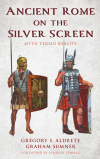Zusammenfassung
An unparalleled exploration of films set in Ancient Rome, from the silent Cleopatra to the modern rendition of Ben-Hur.
No sooner had the dazzling new technology of cinema been invented near the end of the 19th century than filmmakers immediately turned to ancient history for inspiration. Nero, Cleopatra, Caesar, and more all found their way to the silver screen and would return again and again in the decades that followed. But just how accurate were these depictions of Ancient Rome?
In Ancient Rome on the Silver Screen: Myth versus Reality, Gregory S. Aldrete and Graham Sumner provide a fascinating examination of 50 films set in Ancient Rome, analyzing each for its historical accuracy of plot, characters, costumes and sets. They also divulge insights into the process of making each movie and the challenges the filmmakers faced in bringing the Roman world to vivid cinematic life. Beginning with the classics from the dawn of cinema, through the great golden age of sword-and-sandals flicks in the 1950s, to the dramatic epics of the modern day, Aldrete and Sumner test the authenticity of Hollywood’s version of history.
Featuring remarkable custom-made paintings depicting characters as they appeared in film and how they should have appeared if they were historically correct, Ancient Rome on the Silver Screen delivers an invaluable perspective of film and history. This unique collaboration between professional illustrator and award-winning Roman historian offers a deeper understanding of modern cinema and brings Roman history to life.
Schlagworte
Rome Hannibal Gladiator ancient Rome Monty Python Nazareth Spartacus Rome in movies Rome on film Rome on screen Pontius Pilate accuracy in film ancient epic Julius Caesar Ben-Hur Claudius Cleopatra Coriolanus Hollywood and Rome modern cinema portrayal of Rome roman history roman movies King Arthur historical accuracy costumes and filmKeywords
cinema Roman Empire- Kapitel Ausklappen | EinklappenSeiten
- i–xxvi Preface i–xxvi
- 207–212 Notes 207–212
- 213–216 Select Bibliography 213–216
- 217–234 Index 217–234
- 235–236 About the Authors 235–236
6 Treffer gefunden
- „... dedication to the Roman state.The real star of the film is Peter Ustinov as Emperor Nero. Ustinov’s Nero is ...” „... and domineering agents of totalitarian power structures, typically the Roman state itself. Thus, in ...” „... 1950s Hollywood ideology in which the United States was justifiably viewed as having nobly defended the ...”
- „... as if I’d found a secret door that led right to the heart of the ancient world.”3 Cleopatra (1917 ...” „... , Metro-Goldwyn-Mayer obtained the rights, but the production was troubled. The initial attempt to film in Italy ...” „... ancient galleys, including those of Greek states such as Athens during the Persian and Peloponnesian Wars ...”
- „... , has black hair, and fights right-handed.The producers’ stated intention was to avoid the stereotypical ...” „... posted to northern climes wore leather pants that reached down to the calf, as seen in the right ...” „... success, raking in over $300 million in the United States and over $600 million worldwide. It set a number ...”
- „... . The ancient source for this trip states that she sailed up the river Cydnus in a gilded barge powered ...” „... making our empires fall.”5 With the United States then at the pinnacle of its economic and political ...” „... achieved it will bring to all the supreme rights of Roman citizenship.” He memorably concludes with the ...”
- „... big-budget Hollywood Cleopatra in England fell apart and production shifted to the United States, the Carry ...” „... December of 1976 and then, the following year, was shown in the United States on PBS as episodes of the ...” „... . The director, Herbert Wise, stated, “We agreed right at the beginning that we weren’t going to make a ...”
- „... KingdomCopyright © 2023 by the Rowman & Littlefield Publishing Group, Inc.All rights reserved. No part of this book ...” „... . For example, in the United States, the Cold War was perceived by many as a life-and-death ideological ...”

